According to the most recent APPA study, 66% of American households now own a pet, generating almost $150 billion sales in the U.S. each year.
That’s a lot of money for the taking.
But with this boom has come more competition than ever for pet-related businesses, products, and services. Getting your brand seen and heard through all this noise — not to mention converting picky pet parents — can be a monumental challenge, but it’s one that can be solved with the right marketing strategy.
Here at Inflow, we’ve guided both brick-and-mortar and online stores through these industry-specific obstacles to achieve incredible growth results. From the doubling of overall revenue to seven-figure sales months, we’ve helped transform our pet clients’ businesses through custom, optimized marketing strategies that other agencies overlook.
And, in today’s guide, we’re pulling back the curtain to show you how.
Below, we’ve shared nine proven strategies commonly used for our pet industry clients — most notable, online retailer Tactipup — to help your brand find the same level of success.
Want more pet business marketing strategies like these? Visit us at the Global Pet Expo from March 20–22, or request a free strategy proposal from our team today.
The video below is hosted on YouTube. If you need assistance with viewing the video, please contact info@goinflow.com.
9 Pet Industry Marketing Ideas to Take Your Brand to the Next Level in 2024
A crowded market is just one challenge awaiting your pet brand in 2024. In the months to come, you’ll also see a massive update to Google’s organic search results, the phasing out of third-party cookies, the rise of AI-assisted shopping, and much more.
To keep your business at the front of the pack, we’ve curated nine of our team’s most effective marketing strategies into the list below. Use them to build a marketing foundation that helps your business outlast the latest viral trends and sustainably grow your customer base, revenue, and sales.
However, remember that the best marketing for pet businesses comes from strategies and tactics developed for individual brands and their unique challenges. If you would like us to review your team’s approach and create a custom, revenue-focused strategy for your situation, please contact us for a free consultation and proposal.
1. Create campaigns that target the entire sales funnel.
Most pet businesses are (understandably) focused on their bottom line — converting as many customers as possible into tangible revenue. However, when your marketing efforts only focus on that goal, you’re cutting your growth possibilities off at the knees.
In our 16+ years of experience, the most successful pet marketing campaigns incorporate the full buyer journey: interest/awareness, consideration, purchase, and retention. By targeting goals like brand awareness and customer engagement, not just sales, you can better fill your pipeline of potential customers or leads over time.

This, in turn, prevents stagnation when your existing audience base is tapped out.
Our full-funnel strategy is best represented by a “See, Think, Do” approach, one which we deploy for all of our clients. While we frequently apply this concept to social media advertising alone, it can also be used across all marketing channels.
Here’s an example of how your brand could put this strategy into action:
- Improve online presence through organic social media marketing and social media advertising.
- Educate through the consideration phase with content marketing on your website, blog, email campaigns, and more.
- Push customers to convert with targeted Google Ads and social media advertising.
- Retain your loyal customers with email marketing and ad retargeting.
Remember: Each of these stages (and associated campaigns) will have different goals. They will not all generate cold, hard cash, but they do play a crucial role in creating a steady stream of revenue.
Of course, to effectively implement this strategy, you’ll need a clear understanding of how your audience is moving from one stage to the next. Fortunately, you can dive deeper into your buyer journey with conversion paths in Google Analytics 4.
Learn more in the video below:
The video below is hosted on YouTube. If you need assistance with viewing the video, please contact info@goinflow.com.
2. Use an omnichannel marketing approach.
As you’ve likely gathered from the tip above, you can’t rely on one marketing channel to keep your business afloat. Sure, many new products are launched through virality on TikTok or Instagram Reels — but without outreach on other channels, those sales can quickly fizzle out.
When you rely on a single marketing channel, your business is at the mercy of that platform’s algorithm, unpredictable virality, and yo-yoing ad performance. By expanding your advertising efforts, you can still maintain results where your audience first found you but also find new audiences where you may least expect them.
Take Tactipup as an example. The online retailer had originally found success with Facebook and Instagram ads — but, as our agency team found in our initial audit, they were neglecting crucial channels like paid search advertising.
When reviewing Tactipup’s customer journey, we discovered that many customers traveled back and forth between paid social and search channels before making their final purchase:
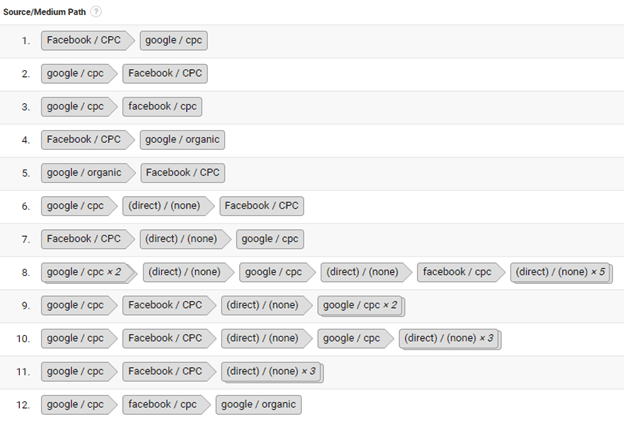
By investing time and money into these PPC campaigns (while still running their social ads), we were able to fill the gaps in that funnel and ensure that interested customers found Tactipup and its products wherever they happened to be searching, resulting in more than $500,000 in sales in one month alone. (Read more about our approach here.)
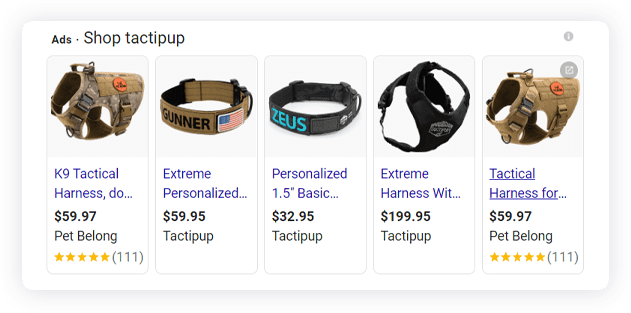
Note: With Google’s Search Generative Experience set to shake up the Google Shopping listings, having a strategy for your product listing ads will be instrumental for appearing in the organic results. If you’re not already doing so, make sure to set up your product listing ads and optimize your product data feed.
3. Employ affiliate marketing with influencers — but be strategic about it.
Pet brands and influencers go hand in hand. In an industry that relies heavily on organic visibility and attractive creative, it’s no wonder that top brands choose to partner with affiliate marketers to enhance product awareness.
However, as influencer marketing has developed, it’s gotten much more complex. Generating revenue from these partnerships involves more than just paying a pet influencer to show off your product in their latest video. Without the proper research and planning, your brand could just be throwing money away.
Here are a few things to consider:
- How does your target audience align with that of the influencer? Influencers like Doug the Pug may have millions of followers, but not all of those are active pet owners looking to purchase from your brand. In other words, don’t fall into the trap of advertising your product to a bunch of non-pet owners who follow the account just to see cute photos.
- Will your placement be authentic or awkward? Consumers value authenticity more than anything else. An obvious ad can bring a social media feed to a screeching halt — and even turn consumers off from your brand entirely. If you can, it’s best to find existing customers for affiliate marketing, which will read more authentically.
- Do nontraditional influencers fit the bill? Lots of pet brands partner with popular dog influencers, but not as many take the route of partnering with veterinarians, groomers, and other industry professionals. This can be an ideal route for pet food or health products, considering that these professionals have built a degree of trust with their audiences, simply by the nature of their careers.
4. Crowdsource a variety of video and image creative.
User-generated content is king for today’s pet brands and should be an integral part of your advertising library.
This type of content lends authenticity to your pet product or service. It proves that people are using your brand in their day-to-day life, showing prospective customers how your brand may fit into theirs, too.
And, with reliability in advertising being nearly twice as important as popularity, UGC is the key to connecting with your audience.
Gathering this content should be fairly easy (after all, most consumers love sharing photos of their furry friends), but here are some tips to keep in mind:
- UGC doesn’t have to be of high-production quality. We’ve run dozens of tests here at Inflow, and the result is clear: Your creative doesn’t need to be professional-quality to resonate with consumers. In fact, sometimes average-quality UGC from your customers will perform better than professionally produced videos and images!
- Customer incentives can be incredibly effective. If you’re at a loss for where to find UGC featuring your brand, start with your existing customer list. Offer gift cards for leaving photo reviews on your website, or host a giveaway to inspire creative videos and images.
- Branded hashtags are the way to go. If you don’t already have one, start using a branded hashtag on all of your social posts. Your loyal followers will catch on and use the same one when posting their UGC, making it much easier for you to locate in the future.
- Customers should NEVER be told what to say. People know when UGC is scripted, and it kills any sense of trust they have with your brand. Allow your customers to use the phrasing and pain points most applicable to them. You’ll have the final say in whether to use their content, but their input could reveal new messaging opportunities and selling points for your brand.
Employ user-generated content in your organic social feeds, paid social campaigns, website, email marketing, and other campaigns. The more you use it, the better.
Just make sure you have enough variety to avoid fatiguing your audiences!
5. Advertise in underutilized markets.
As you expand your omnichannel marketing strategy, consider using ad channels like Reddit, Pinterest, and connected TV to reach new audiences. For many businesses, these channels are cheaper than expected — and, when managed correctly, hold massive potential (such as the 250% increase in sales generated for one eCommerce client).
Choosing the right advertising platforms can be tricky, but an experienced agency such as Inflow can evaluate your brand strengths and weaknesses to recommend the best for your business.
For example, Pinterest can be a slam dunk for personalized pet supplies like collars, due to their visual appeal. It’s also a space where many major pet stores are failing to advertise, as seen in the screenshot below.
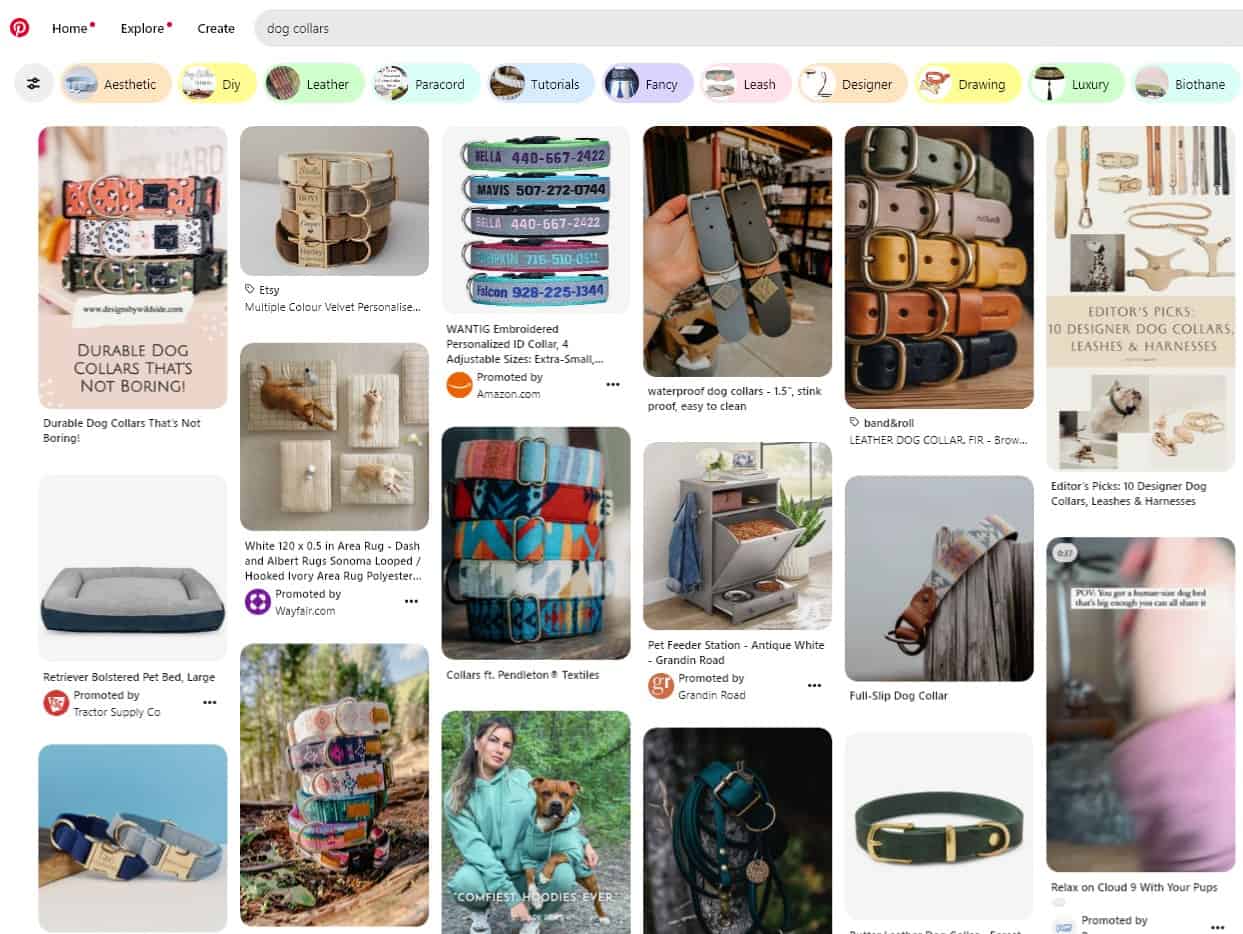
With privacy-related updates restricting audience data on trusted platforms like Meta, diversifying your advertising efforts today will put your brand in a much stronger position and prevent stagnating results from an overreliance on one channel.
6. Nurture customers with educational content marketing.
Cute images and videos can only get your brand so far. With so much competition out there, your business also needs to convince your audience to purchase your product instead of others — and content marketing can be the best way to do that.
We highly recommend every pet brand employ a blog to answer commonly asked questions, drive new customers to your site, and keep your brand at the top of mind. Blog content need not only concern your products; proper keyword research can reveal related topics that resonate with your audience.
For example, our former client Pawstruck uses its blog content to address any questions regarding pet food, including scientific research and listicles to educate and inform customers. By targeting related keywords (such as “best treats for pit bulls”), the brand can bring in prospective buyers via strategic search engine optimization (SEO) — not to mention use this content on its chosen social media platforms and in email marketing to keep its audience engaged.
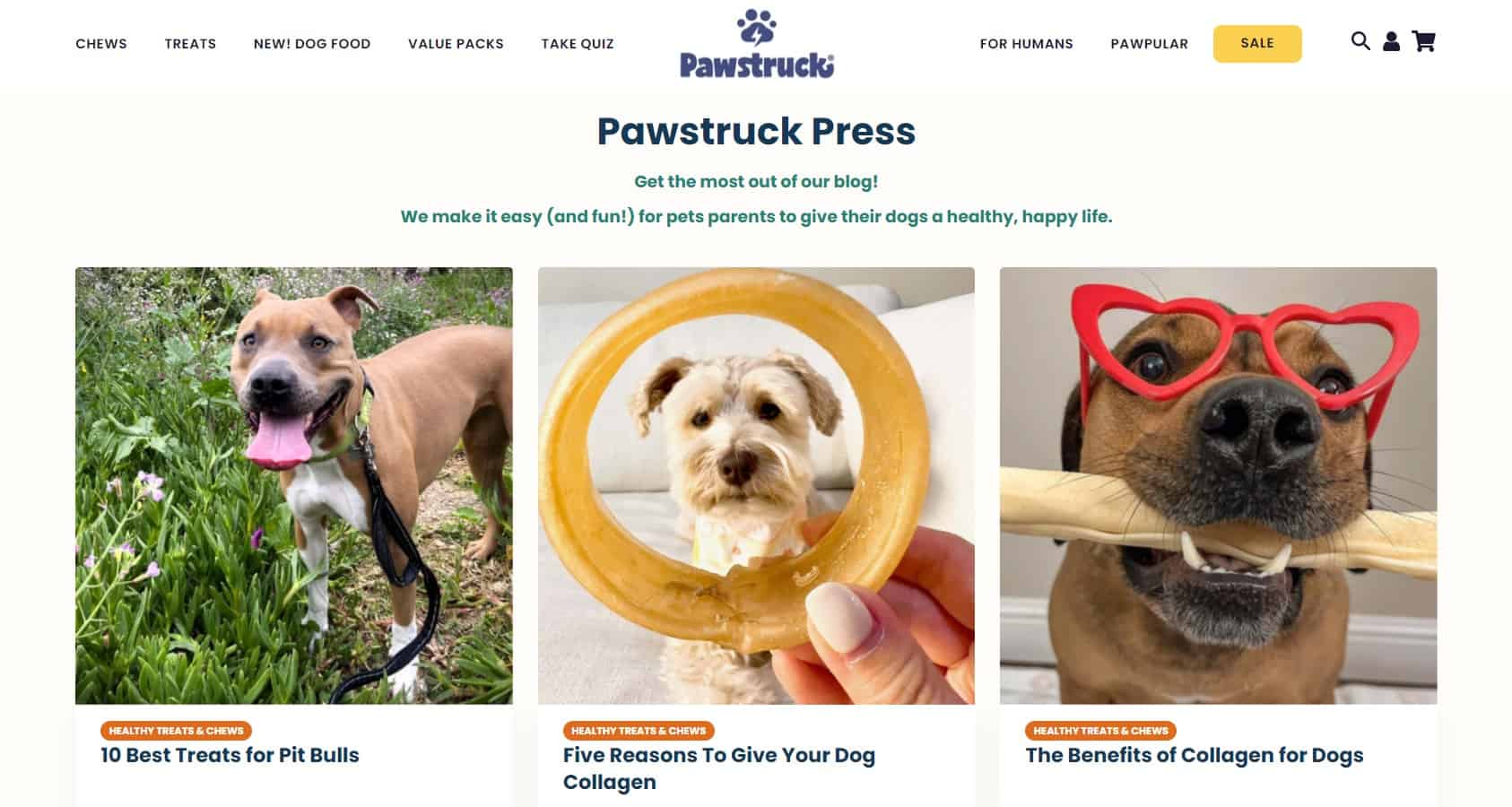
For more tips on creating an effective content marketing strategy, read through our comprehensive guide or view these content marketing examples.
7. Incorporate seasonality into your ad creative and copy.
For many owners, pets are family members and are treated as such, especially around the holidays. This can be a gold mine for your pet product brand, as long as your marketing campaigns account for this behavior.
Seasonal creative and copy is a great way to tap into your audience during a given holiday season. Remind your audience that their pet “deserves the best Christmas dinner/gift/etc.” while promoting your products.
You should also incorporate seasonality into your paid search campaigns. Keywords like “gifts for dogs” may have lots of competition, but what about more niche keywords like “Christmas dog toys” or “dog toys Christmas sale”?
Tap into those searches, and you’ll tap into a new audience for your pet brand.
8. Create a loyalty or subscription program.
Take a page out of Chewy’s book, and make a loyalty or subscription program part of your 2024 initiatives.
If you sell dog food, an auto-ship subscription is a great way to create a loyal customer base. Pets always need more food, and, by anticipating that need with an auto-ship schedule, you remove that pain point for your customer.
Barkbox is a similar concept. For pets that consistently destroy toys (or for humans who love giving their fur children special gifts), a subscription box guarantees replacements and a sense of excited anticipation for both pet and owner.
A loyalty program can also reward your repeat customers, building a sense of connection and reducing the likelihood of customer churn. Special discounts and gifts can keep your customers coming back for more, as well as generate positive word-of-mouth regarding your customer service.
Learn more about building brand loyalty here.
9. Incorporate your value proposition into every marketing campaign.
Finally, whatever marketing efforts you decide on, communicate a consistent message throughout them. This should be your value proposition: the reason why customers should choose you over the thousands of other options out there.
Often, your brand value proposition will develop naturally out of your customer base. For Tactipup, it’s the value of overbuilt, hard-to-destroy pet gear with a uniquely American flair. Their messaging leans into this and informs their audience targeting in every single campaign.
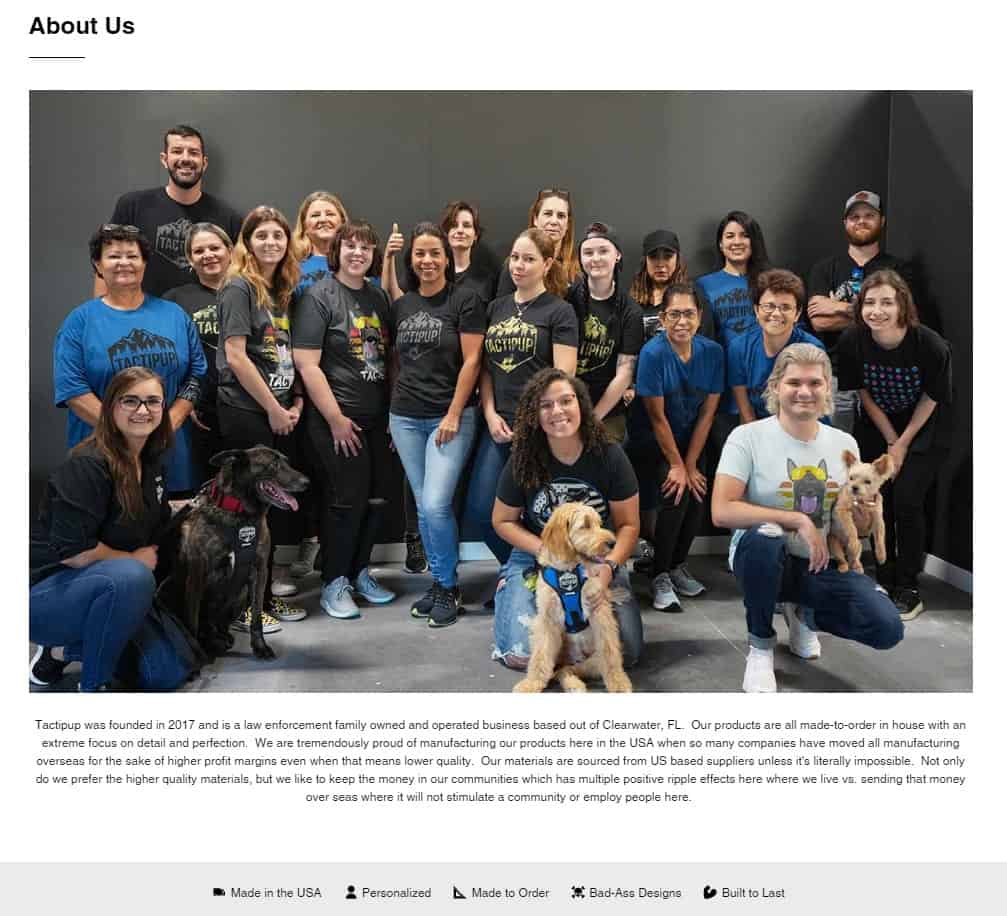
Ideally, you already have your value proposition figured out. If you don’t, it’s time to do some soul searching. Conduct audience research, talk to your stakeholders, and do some competitor analysis to see what drives customers to your brand over others.
Some popular messaging in the pet care industry:
- Ethical production processes and cruelty-free products
- Sustainable, eco-friendly products
- Personalization and customization
- Locally owned and operated
If any of these apply to your brand, start testing your marketing campaigns with appropriate copy to see what resonates best with your customers.
Optimize Your Pet Brand Marketing Strategy With Inflow’s Help
With the pet industry set to grow exponentially, building the right marketing foundation for your brand will be instrumental in outlasting your competition in the years to come. And, while any business can post cute dog photos on their social pages, the real marker of a long-lasting brand is a strategic omnichannel approach.
It’s worked for brands like Tactipup, Pawstruck, and more — and it will work for your business, too.
If you need an expert hand in building that digital marketing strategy, our team is here to help. With our decades of experience in the pet industry, we can craft a personalized approach that achieves your growth goals through smart, sustainable campaigns.
Learn more by requesting a free consultation and strategy proposal today.











0 Comments